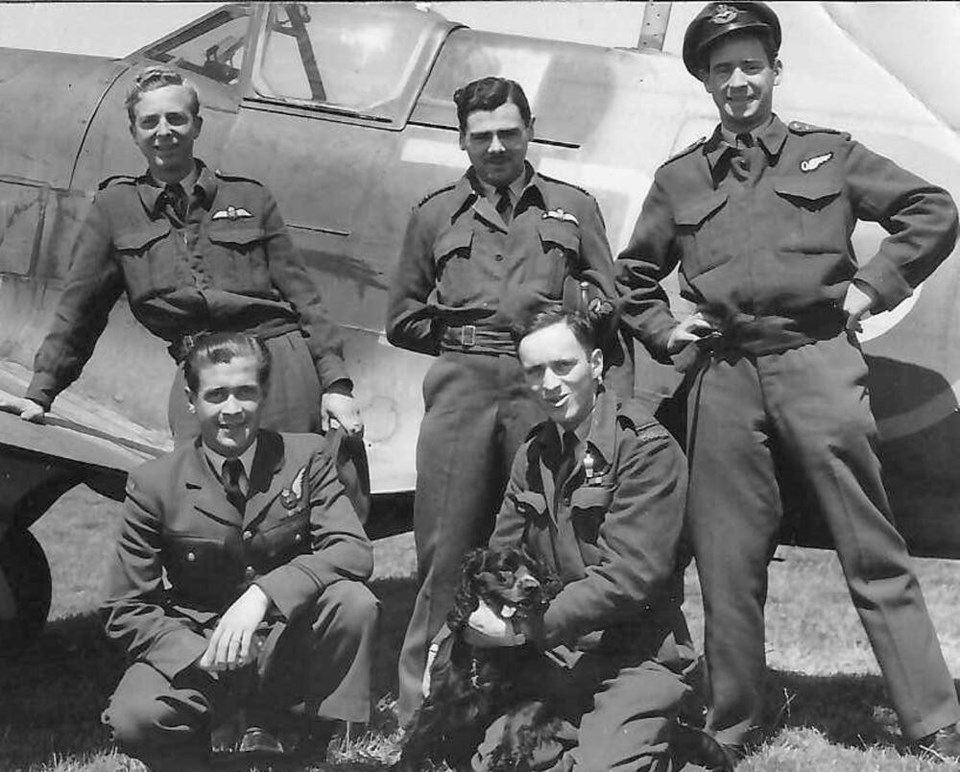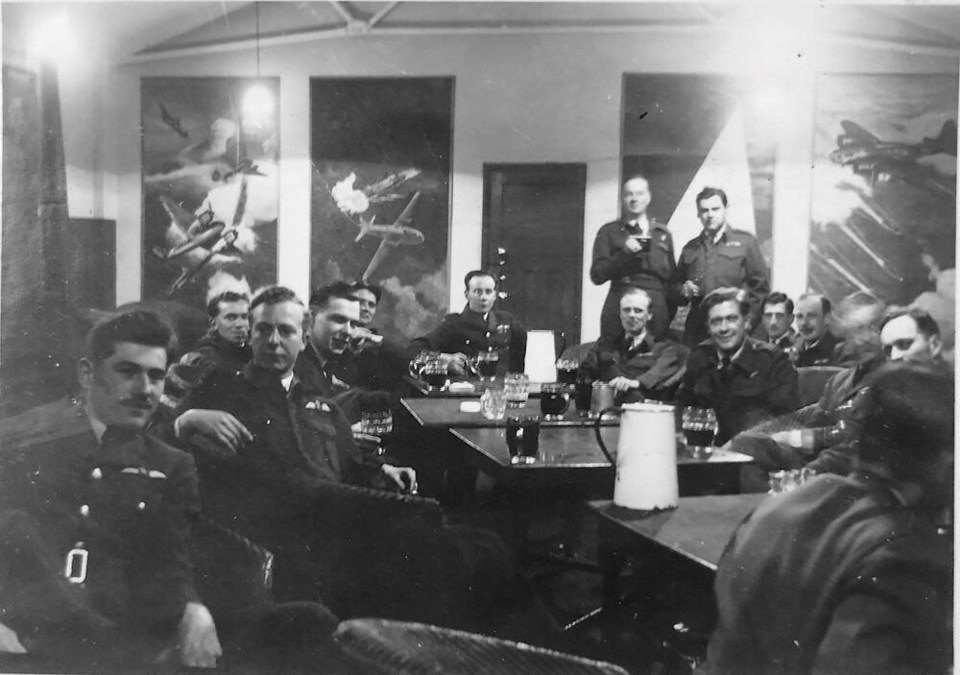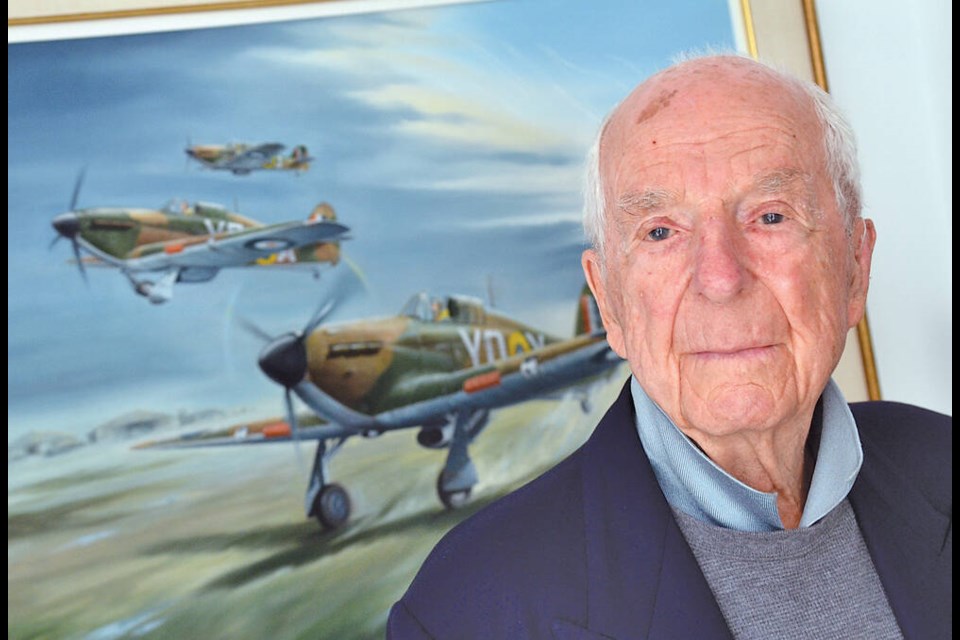The Royal Canadian Air Force CP-140 Aurora dipped low, down to just about 60 metres over the water. Not much lower than Ran Clerihue would have flown more than 80 years ago, as a Second World War pilot hunting for enemy submarines.
This time though, Clerihue earned the pleasure of watching the military flyby from a yacht on Howe Sound where, on June 1, he celebrated his 100th birthday with friends and family.
The plane took off from Canadian Forces Base Comox, piloted by members of the 407 Demon Squadron, which Clerihue is now the last surviving member of from the war.
Clerihue was 16 at the time the Second World War broke out. He enrolled at UBC to study commerce, but there was little question what he would do when he turned 18. He was already a member of the Air Cadets. His father was a veteran pilot from the First World War and he wanted to follow in his footsteps.
“He wasn’t that enthusiastic about his son going to war. He lost a brother during World War One at Vimy. He survived at flying and I thought I could do that and survive,” Clerihue recalls.
Clerihue shipped off for training in Alberta where he graduated at the top of his class. As such, he was asked what type of posting would be his first choice. He wanted to be a fighter pilot, but at that time, the Battle of the Atlantic was going badly for the Allies with German U-boats attacking military, merchant and civilian vessels needed to support the war effort in Europe.
For the next year, he was deployed to Nova Scotia’s 117 Squadron to patrol the North Atlantic for German subs.
Clerihue was a slight teenager, something the squadron’s commanding officer called attention to, publicly, the day they met.
“I think he thought I was about 14 years old, and he looked at me and said, ‘Holy cow, what the hell are they sending me now? Tiny Tim as replacement?” Clerihue says with a laugh.
The C.O. introduced Clerihue to the rest of the squadron and brass in the officers’ mess as “Tim” and the name stuck with him for the duration of the war.

On patrol
When they spotted a German submarine from their PBY Catalina flying boat, they were expected to go into a dive and drop depth charges to sink or disable the target below.
“I got shot at a couple times,” Clerihue said. “U-boats fight back, but it never concerned me to go back up again.”
On a few occasions, after an attack, they were told they were responsible for a “probable” sinking of an enemy ship.
The threat the U-boats posed shouldn’t be understated, said Jerry Vernon, president of the Vancouver chapter of the Canadian Aviation Historical Society.
“Submarines were really pesky in the Battle of the St. Lawrence,” he said, noting the U-boats reached as far as Rimouski, just 250 kilometres from Quebec City. “There were quite a few ships sunk in that area by submarines who were inside our waters.… They were sent out to cause as much disruption as they could until they ran out of torpedoes.”
Thanks to the efforts of the Allies, within five months of Clerihue’s deployment, most of the U-boats threatening the Atlantic’s shipping lanes were destroyed. Pilots like Clerihue were instrumental in turning the tide, allowing military supplies and resources to arrive safely in England and Europe where the Allies needed them most, Vernon said.
In 1943, Clerihue was sent to Ceylon (now Sri Lanka) where he joined 413 Squadron in the hunt for Japan’s subs in the Indian Ocean.
In the last year of the war, Clerihue was sent to 407 Demon Squadron, based in Devon, England. They were flying mainly night missions in Wellington bombers with massive spotlights installed on their bellies to search for subs at night. By that point in the war, German subs were much harder to come by, and Clerihue never spotted a single one.
Much to the relief of his father, Clerihue came home. A great many weren’t so lucky, Vernon said.
The 407 lost a lot of crews, including 28 Hudson bombers and 14 Wellingtons. Officially that amounted to 233 crew members killed, 171 of which were listed as Missing and Presumed Dead.
“Quite of few of them just disappeared at sea and they didn’t know what happened to them,” Vernon said.
Clerihue lost friends in the war, although more often from their planes going down in bad weather than because of the enemy, he said.

Peace time
When the war was over, Clerihue could have kept flying, pursuing a career in commercial aviation. But he was eager to get back to his studies at UBC. It was a decision that served him well. He went on to become an executive with Celanese Corporation, which took him to Montreal and New York. He married his childhood sweetheart and they had a daughter – the one who arranged for the tribute flyby from the RCAF on June 1.
When it was time for him to retire, he settled in West Vancouver where he still lives today.
Clerihue said he didn’t spend a lot time after the war contemplating his service, although for most of his life, he has been volunteering and raising money for the Air Cadets.
In the 1980s, he met up with is old commanding officer from Nova Scotia – the one who gave him the nickname Tim – at an Air Cadets function.
“At that time, he told me that I was the best flyer on his squadron,” Clerihue said with a hint of pride in his voice.
At 100 years old, Clerihue said he’s now the last surviving member of any of the three squadrons he served in.
Today, 407 Squadron flies out of Canadian Forces Base Comox, where they still are tasked with long-range patrols.
Usually, when they do a flyby, it’s to gather intel or send a message to a boat on the water, said 407 Squadron Capt. Kalina Yurick. Flybys as tributes are rarer. And doing them in to honour surviving member of 407 from wartime is almost unheard of.
“The commanding officer was immediately interested in supporting whatever event we can to commemorate this gentleman,” Yurick said. “Those opportunities are going to be very rare. I have not heard of this happening in a very long time.”
Yurick said it was very meaningful for her crew to see things come full circle and salute someone whose name is recorded in the same mission logs they maintain today.
“World War Two veterans, obviously, hold a special place for us serving members here at 407. It’s great to be able to connect with those people who have done the job before us and to say thank you,” she said. “It’s nice to connect to our roots once in a while and remember that we come from a long line of service.”
As Yurick’s crew approached Howe Sound, Clerihue and his guests clambered on to the deck of their boat. He waved eagerly and beamed as the Aurora flew overhead.





